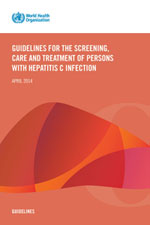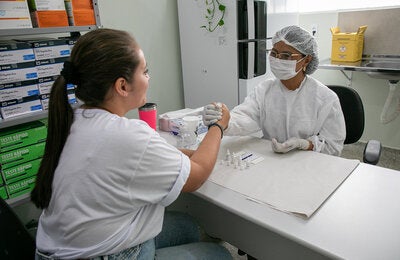

WHO has issued its first guidance for the treatment of hepatitis C, a chronic infection that affects an estimated 130 million to 150 million people and results in 350 000 to 500 000 deaths a year. The publication of the "WHO Guidelines for the screening, care and treatment of persons with hepatitis C infection"...
WHO has issued its first guidance for the treatment of hepatitis C, a chronic infection that affects an estimated 130 million to 150 million people and results in 350 000 to 500 000 deaths a year.
 The publication of the "WHO
Guidelines for the screening, care and treatment of persons with hepatitis C
infection" coincides with the availability of more effective and safer
oral hepatitis medicines, along with the promise of even more new medicines in
the next few years.
The publication of the "WHO
Guidelines for the screening, care and treatment of persons with hepatitis C
infection" coincides with the availability of more effective and safer
oral hepatitis medicines, along with the promise of even more new medicines in
the next few years.
WHO will be working with countries to introduce the guidelines as part of their national treatment programmes. WHO support will include assistance to make the new treatments available and consideration of all possible avenues to make them affordable for all.
In the Americas, between 8 million and 11 million people suffer from chronic hepatitis B infection, and 7 million have chronic hepatitis C. This disease puts a heavy burden on health-care systems because of the high cost of treatment. In many countries it is the main cause for liver transplants.
Nine key recommendations
The new guidelines make nine key recommendations. These include approaches to increase the number of people screened for hepatitis C infection, advice as to how to mitigate liver damage for those who are infected and how to select and provide appropriate treatments for chronic hepatitis C infection.
Screening
WHO recommends a screening test for those considered at high risk of infection, followed by another test for those who screen positive, to establish whether they have chronic hepatitis C infection.
Mitigating liver damage
Since alcohol use can accelerate liver damage caused by hepatitis C, WHO now advises that people with chronic hepatitis C infection receive an alcohol assessment. The Organization also recommends providing counseling to reduce alcohol intake for people with moderate or high alcohol use. In addition, the guidelines provide advice on the selection of the most appropriate test to assess the degree of liver damage in those with chronic hepatitis C infection.
Treatment
The guidelines provide recommendations on existing treatments based on interferon injections as well as the new regimens that use only oral medicines. WHO will update recommendations on drug treatments periodically as additional antiviral medicines are registered on the market and new evidence emerges.
Prevention
The 2014 recommendations also summarize for policy makers and health care workers interventions that should be put in place to prevent transmission of hepatitis C, including measures to assure the safety of medical procedures and injections in health care settings and among persons who inject drugs. Rates of new hepatitis C infections remain unacceptably high in many countries because of the reuse of injection equipment and lack of screening of blood transfusions.
There are five main hepatitis viruses, referred to as types A, B, C, D and E. Hepatitis B and C have the greatest public health impact because they cause chronic infection which can progress to cirrhosis and liver cancer. Hepatitis A and E, spread though unsafe water and contaminated food, have the potential to cause outbreaks in certain populations.
Hepatitis C virus is most commonly transmitted through exposure to contaminated blood. Those at risk include people undergoing invasive medical procedures and therapeutic injections where there is poor infection control. Also at risk are those exposed to contaminated injecting and skin piercing equipment, including through injecting drug use, tattooing and body piercing.
Links:



